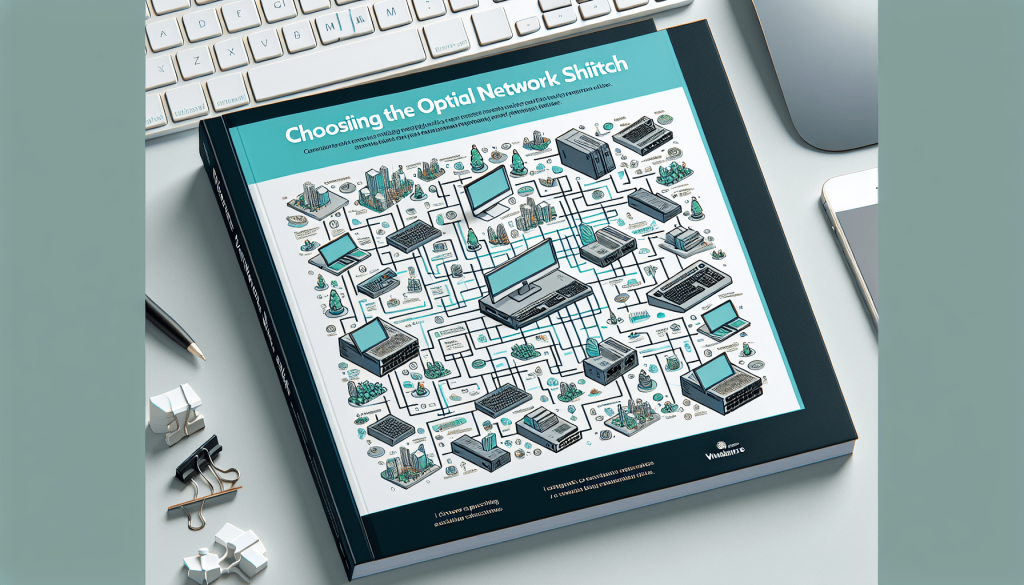In this informative article, you will discover the ultimate guide to choosing the best network switch for your business. Whether you’re a small start-up or a well-established company, selecting the right network switch is crucial for seamless communication, efficient data transfer, and optimal network performance. We will explore the factors to consider, such as port capacity, speed, and compatibility, to help you make an informed decision that meets your business requirements. So, let’s dive into the world of network switches and find the perfect fit for your organisation!

Understanding Network Switches
What is a network switch?
A network switch is a device that connects multiple devices, such as computers, servers, printers, and access points, within a local area network (LAN). It allows these devices to communicate with each other by forwarding data packets between them. Unlike hubs, switches provide a dedicated connection for each connected device, offering improved performance and efficiency.
Why is choosing the right network switch important?
Choosing the right network switch is crucial because it forms the backbone of your business network. It determines the connectivity, performance, and scalability of your network infrastructure. A well-chosen network switch can support your business’s current needs and future growth, while an inadequate one can lead to bottlenecks, slow network speeds, and limited expansion capabilities.
Different types of network switches
Network switches come in various types, each offering different features and capabilities. The key types include unmanaged switches, managed switches, Layer 2 switches, Layer 3 switches, and Power over Ethernet (PoE) switches.
-
Unmanaged switches: These switches are plug-and-play devices that require no configuration. They are suitable for small businesses with basic networking needs.
-
Managed switches: These switches offer advanced features and configurability. They allow for improved control, security, and performance optimization. Managed switches are ideal for medium to large businesses or those with specialized networking requirements.
-
Layer 2 switches: Layer 2 switches operate at the data link layer of the network. They use MAC addresses to determine the path for forwarding network traffic. These switches are common in small to medium-sized networks.
-
Layer 3 switches: Layer 3 switches, also known as routing switches, can perform routing functions in addition to switching. They can make intelligent routing decisions based on IP addresses and provide better performance and scalability for larger networks.
-
PoE switches: Power over Ethernet switches provide both data and power over a single Ethernet cable. They eliminate the need for separate power adapters, making them ideal for devices such as IP phones, wireless access points, and security cameras.
Assessing Your Business Needs
Determining the size of your network
To choose the right network switch, you need to assess the size of your network. Consider the number of devices that will be connected to the switch and the physical layout of your office or building. This information will help determine the number of ports and the physical form factor you require.
Identifying required port density
Port density refers to the number of ports available on a switch. Evaluate the number of devices you need to connect and consider future growth. Ensure the switch has enough ports to accommodate your current and future needs. It’s also important to consider the type of ports required, such as Ethernet or fiber optic, depending on your network infrastructure.
Considering future scalability
When choosing a network switch, it’s essential to consider future scalability. Determine if the switch supports additional expansion modules or if it can be stacked with other switches to increase capacity. Planning for future growth ensures that your network switch can accommodate evolving business requirements without requiring a complete overhaul.
Examining network traffic patterns
Analyzing network traffic patterns can help you choose the right switch. Consider the types of applications and services your business relies on, the volume of data being transmitted, and potential peak traffic periods. This information will guide you in selecting a switch with sufficient bandwidth and throughput capabilities to handle your network’s demands.
Assessing power and energy efficiency needs
Power and energy efficiency are crucial considerations for businesses looking to minimize operating costs and reduce their environmental footprint. Look for switches that offer advanced power management features, such as Energy-Efficient Ethernet (EEE) and power scheduling. These features can help optimize power consumption and reduce energy waste.
Choosing the Right Switching Technologies
Unmanaged switches
Unmanaged switches are ideal for small businesses or home offices with simple networking requirements. They are easy to install and require no configuration, making them plug-and-play devices. While unmanaged switches lack advanced features and customization options, they provide basic connectivity for connecting devices within a LAN.
Managed switches
Managed switches offer advanced features and control over your network. They provide the ability to configure, monitor, and manage individual ports, VLANs, Quality of Service (QoS), Link Aggregation, and more. Managed switches allow for improved network security, performance optimization, and troubleshooting capabilities. They are essential for medium to large businesses or those requiring specific networking customization.
Layer 2 switches
Layer 2 switches operate at the data link layer of the network. They use MAC addresses to forward network traffic between devices within a LAN. Layer 2 switches are cost-effective and efficient for small to medium-sized networks where basic network connectivity is required.
Layer 3 switches
Layer 3 switches, also known as routing switches, combine the functions of a switch and a router. They can make intelligent routing decisions based on IP addresses, improving network performance and scalability. Layer 3 switches are ideal for larger networks with complex routing needs.
PoE switches
Power over Ethernet (PoE) switches provide both data connectivity and power to devices over a single Ethernet cable. They eliminate the need for separate power adapters, simplifying installation and reducing cable clutter. PoE switches are commonly used to power devices such as IP phones, wireless access points, security cameras, and IoT devices.
Understanding Switch Specifications
Switching capacity
Switching capacity refers to the total amount of data that a switch can process at any given time. It is measured in terms of gigabits per second (Gbps) or terabits per second (Tbps). Higher switching capacity allows for faster and more efficient data transfer within the network.
Forwarding rate
The forwarding rate indicates the speed at which a switch can process and forward data packets. It is measured in packets per second (pps) or megabits per second (Mbps). A higher forwarding rate ensures smooth and uninterrupted data transmission, even under high network loads.
Number of ports
The number of ports determines how many devices can be connected to the switch. Consider your current and future connectivity needs when evaluating the number of ports required. Remember to factor in the availability of different types of ports, such as Ethernet or fiber optic, based on your network infrastructure.
Port speed
Port speed refers to the maximum data transfer rate supported by each port. Common port speeds include 10/100 Mbps (Fast Ethernet) and 1 Gbps (Gigabit Ethernet). Select port speeds that align with your network’s requirements to ensure optimal performance.
Buffer size
Buffer size refers to the amount of memory reserved for temporarily storing incoming and outgoing data packets. Adequate buffer size helps prevent data loss or packet drops during periods of high network traffic.
VLAN support
Virtual Local Area Networks (VLANs) allow for the segmentation of a network into multiple subnetworks, enhancing security and network management. Choose a switch that supports VLANs if you require network segmentation for different departments, projects, or guest access.
QoS support
Quality of Service (QoS) allows for the prioritization of network traffic based on specific criteria, such as latency or bandwidth requirements. QoS support is essential for businesses that rely on real-time applications, such as video conferencing or VoIP, to ensure optimal performance and minimize network congestion.
Redundancy and failover options
Redundancy and failover options provide backup and fault tolerance in case of component failure. Look for switches that support features like Spanning Tree Protocol (STP), Rapid Spanning Tree Protocol (RSTP), or Virtual Router Redundancy Protocol (VRRP) to ensure uninterrupted network connectivity.
Security features
When choosing a network switch, consider the security features it offers. Look for features such as Access Control Lists (ACLs), port security, Secure Shell (SSH), and SNMPv3 support. These features help protect your network against unauthorized access, data breaches, and network attacks.

Considering Performance and Scalability
Bandwidth requirements
Evaluate your business’s bandwidth requirements by considering the types of applications and services used within your network. Calculate the maximum bandwidth needed to ensure smooth data transmission and minimize latency or bottlenecks.
Throughput and latency
Throughput refers to the amount of data that can be transmitted over a network within a specific time frame. Low latency is crucial, especially for real-time applications, as it indicates a minimal delay between data transmission and reception. Choose a switch with high throughput and low latency for optimal network performance.
Stacking capabilities
Stacking allows multiple switches to be interconnected and managed as a single unit. Stacking improves scalability, simplifies network management, and enhances fault tolerance. Consider the stacking capabilities of a switch if you anticipate future growth or need a scalable network solution.
Virtualization support
If your business relies on virtualization technology, choose a switch that supports Virtual Machines (VMs) and can handle the demands of a virtualized environment. Look for features such as Virtual Local Area Networks (VLANs), Quality of Service (QoS) for VM traffic, and Network Virtualization using Generic Routing Encapsulation (NVGRE) or Virtual Extensible LAN (VXLAN) support.
Quality of Service (QoS)
Quality of Service (QoS) ensures that critical network traffic receives priority over less time-sensitive traffic. It allows you to allocate network resources and bandwidth to specific applications or services, improving performance and user experience. Consider a switch with advanced QoS capabilities if your business relies on real-time applications or if you require strict traffic prioritization.
Evaluating Management and Monitoring Capabilities
Web-based management interfaces
Web-based management interfaces provide a user-friendly graphical interface for configuring and managing network switches. These interfaces offer an intuitive way to monitor and control switch settings, VLANs, QoS policies, and security features. Look for switches with easy-to-use web-based management interfaces for simplified network administration.
Command Line Interface (CLI)
Command Line Interface (CLI) is a text-based interface that allows for more granular control over network switch configuration. It is typically used by IT professionals and network administrators to perform advanced troubleshooting, configuration, and monitoring tasks. Consider a switch that offers a CLI if you require fine-tuned control over switch settings.
SNMP management
Simple Network Management Protocol (SNMP) allows for centralized network management and monitoring. SNMP-compatible switches can be monitored and controlled using network management software and provide real-time visibility into network performance and health. Look for SNMP support if you require comprehensive network monitoring and management capabilities.
Performance monitoring
Performance monitoring features provide insight into network utilization, traffic patterns, and possible bottlenecks. Look for switches that offer performance monitoring tools, such as traffic statistics, error counters, and port utilization reports. These features help identify potential issues and optimize network performance.
Traffic analysis
Traffic analysis capabilities allow for detailed analysis of network traffic patterns, bandwidth usage, and application performance. Look for switches that support features like NetFlow or sFlow to collect and analyze data that can help identify potential network congestion, security threats, or performance issues.
Remote management
Remote management capabilities enable network administrators to manage and monitor switches from anywhere using remote access protocols like Secure Shell (SSH) or Virtual Private Network (VPN). This feature is particularly important for businesses with multiple locations or remote workers. Look for switches that offer robust remote management options for convenient and secure access to network controls.
Examining Physical and Environmental Considerations
Rack-mountable vs standalone switches
Consider whether you need a rack-mountable or standalone switch. Rack-mountable switches can be installed in standard server racks, saving space and providing a centralized and organized network infrastructure. Standalone switches, on the other hand, are compact and portable, ideal for small businesses or offices with limited space.
PoE requirements
If your business requires PoE functionality to power devices such as IP phones, wireless access points, or security cameras, ensure the switch supports the required PoE standards (e.g., PoE or PoE+). Consider the power budget of the switch to determine the number of PoE devices it can support simultaneously.
Power redundancy options
Power redundancy options provide backup power in case of a power outage or component failure. Look for switches that offer features like dual power supplies or Power over Ethernet (PoE) backup, ensuring uninterrupted network connectivity even during power disruptions.
Temperature and airflow considerations
Consider the operating temperature range and cooling requirements of the switch to ensure it can withstand the environmental conditions of your business location. Optimal temperature control and proper airflow are essential for preventing equipment failure and maintaining network performance.
Noise level
Noise level can be a consideration, especially if the switch is located in a quiet office environment. Look for switches with low noise levels or consider soundproof enclosures or dedicated network closets to minimize any potential disruption caused by fan noise.
Considering Vendor Reputation and Support
Researching reputable network switch vendors
Conduct thorough research on network switch vendors to ensure reliability, quality, and reputation. Look for vendors with a strong track record of delivering high-quality products and excellent customer support. Consider industry recognition and certifications, such as ISO 9001, as indicators of vendor credibility.
Reading customer reviews and testimonials
Customer reviews and testimonials provide insights into real-world experiences with network switch vendors and their products. Reading reviews from other businesses in similar industries can help you understand the strengths and weaknesses of different vendors. Look for feedback on product performance, reliability, support, and overall customer satisfaction.
Evaluating vendor support and warranty options
Network switches are critical components of your business infrastructure, so it’s crucial to choose vendors that offer reliable support and warranty options. Consider the comprehensiveness of vendor support, including technical assistance, firmware updates, and troubleshooting resources. Evaluate the warranty terms and duration to ensure adequate coverage for your switch investment.
Budgeting and Cost Considerations
Defining your budget
Before exploring network switch options, determine your budget. Define the amount you are willing to invest in a network switch, keeping in mind your business’s current financial situation and long-term growth projections.
Comparing switch prices
Compare switch prices from different vendors to ensure you get the best value for your investment. Consider not only the upfront costs but also the long-term benefits and features offered by each switch. Avoid solely focusing on price, as the cheapest option may not provide the necessary performance, reliability, or scalability.
Considering long-term cost of ownership
In addition to upfront costs, consider the long-term cost of ownership when choosing a network switch. Evaluate factors such as maintenance, power consumption, software licensing, and potential upgrade or expansion costs. Choosing a switch with energy-efficient features or comprehensive management tools can help reduce operational costs over time.
Seeking Professional Advice
Consulting with network professionals
If you are unsure about which network switch is best suited for your business, consider consulting with network professionals, such as IT consultants or network engineers. These professionals can assess your business’s specific needs, offer expert recommendations, and assist with the installation and configuration of your network switch.
Engaging with IT solution providers
IT solution providers offer comprehensive services and solutions to help businesses streamline their networking requirements. Engaging with an IT solution provider can provide you with access to a team of experts who can design, implement, and support your network infrastructure, including the selection of the best network switch for your business.
Seeking vendor recommendations
Don’t hesitate to reach out to network switch vendors for expert advice and recommendations. Vendors can provide valuable insights into their product offerings, assist with evaluating your business requirements, and offer tailored solutions that match your needs and budget. Engaging with vendors directly can help ensure you make an informed decision.
Choosing the best network switch for your business requires careful evaluation of your current and future needs, an understanding of the available technologies and specifications, and consideration of various other factors. By following these guidelines and seeking professional advice when needed, you can make an informed decision that optimizes your network performance, scalability, and cost-effectiveness.
